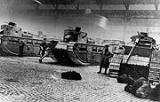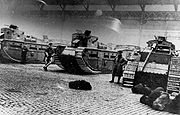
Medium Mark C
Encyclopedia
The Medium Mark C Hornet was a British tank
developed during the First World War, but produced too late to see any fighting.
. In response Major Wilson began to design an improved type on his own, the Medium Mark B
, in July 1917. As soon as he became aware of Wilson's intentions, Tritton ordered his chief designer, William Rigby, to design a rivaling type: the Medium Mark C. The drawings were approved by the British Army
on 19 April 1918. The prototype was finished in August, a few weeks before the Medium B prototype also in construction at Tritton's own factory. At first 200 tanks were ordered; later this was increased to 600, all to be produced by William Foster & Co Ltd
at Lincoln with Armlet & Wortley as subcontractor. The colloquial name of the tank was to be "Hornet", but it seems nobody ever used it.
. It too has the general rhomboid shape of the Mark I and later heavy tanks
combined with a fixed armoured structure, or Casemate
, well forward, fitted with ball-mounts for five machine guns. However, Tritton's Medium Mark C was a much longer vehicle. It had a separate engine compartment at the back like the Medium B, but here it was large enough to house a normal 6 cylinder Ricardo
engine behind a standard epicyclic transmission. Also it was easily accessible from the fighting compartment. The larger engine meant the tank had better speed (about 13 km/h). The greater length gave it a superior trench crossing ability. A fuel tank holding 682 litres of petrol allowed for a range of 225 km. Overall mobility therefore was much better.
Rigby had taken great care to improve the design's ergonomics
. The commander had a special revolving lookout turret and even a small map table. There were eleven vision slits. Special stowage boxes were fitted for the personal gear of the crew of four. Speaking-tubes were used to improve communication. The driver had an odometer
.
 In the (likely) case the Medium Mark D would not be ready for mass production in 1919 the Tank Corps
In the (likely) case the Medium Mark D would not be ready for mass production in 1919 the Tank Corps
hoped to receive no less than 6,000 Medium Cs that year, a third of which of a "Male" version with a long six-pounder gun in the front of the superstructure. Though drawings were prepared nothing would come of this. When the war ended all orders were cancelled with only 36 vehicles nearly finished. These were completed together with fourteen others built from preproduced parts for a total production of fifty. General J.F.C. Fuller
considered switching the budget for the development of the Medium D to a further production of Medium C's so as to fully equip all peace time tank battalions with this better tank, but decided against it. Only the 2nd Tank Battalion
would have the tank. As it was the most modern materiel
of the Tank Corps, it was carefully kept from harm: no Medium C's were sent either with the Expedition Forces against the Bolsheviks in Russia or to the Anglo-Irish War. The only tanks participating in the 1919 victory parade were four Medium C's. The only "action" the tank ever saw was putting down labour unrest in Glasgow
, following the rioting known as the Battle of George Square in 1919.
From 1925 on, the Medium C was gradually replaced by the Medium Mark I
and Medium Mark II
. Proposals to use Medium Cs as recovery vehicles were rejected. A single vehicle was used to test a new type of transmission. In 1940 the last remaining Medium C was melted down.
Tank
A tank is a tracked, armoured fighting vehicle designed for front-line combat which combines operational mobility, tactical offensive, and defensive capabilities...
developed during the First World War, but produced too late to see any fighting.
Development
In 1917 Sir William Tritton had developed the Medium Mark A Whippet without involving his former co-worker Walter Gordon WilsonWalter Gordon Wilson
Major Walter Gordon Wilson was an engineer and member of the British Royal Naval Air Service. He was credited by the 1919 Royal Commission on Awards to Inventors as the co-inventor of the tank, along with Sir William Tritton....
. In response Major Wilson began to design an improved type on his own, the Medium Mark B
Medium Mark B
The Medium Mark B was a British tank of the First World War developed as a successor to the Whippet, but ultimately unsatisfactory and production was cancelled at the end of the war.-History:...
, in July 1917. As soon as he became aware of Wilson's intentions, Tritton ordered his chief designer, William Rigby, to design a rivaling type: the Medium Mark C. The drawings were approved by the British Army
British Army
The British Army is the land warfare branch of Her Majesty's Armed Forces in the United Kingdom. It came into being with the unification of the Kingdom of England and Scotland into the Kingdom of Great Britain in 1707. The new British Army incorporated Regiments that had already existed in England...
on 19 April 1918. The prototype was finished in August, a few weeks before the Medium B prototype also in construction at Tritton's own factory. At first 200 tanks were ordered; later this was increased to 600, all to be produced by William Foster & Co Ltd
William Foster & Co.
William Foster & Co Ltd was an agricultural machinery company based in Lincoln, Lincolnshire, England and usually just called "Fosters of Lincoln." The company can be traced back to 1846, when William Foster purchased a flour mill in Lincoln. William Foster then proceeded to start small scale...
at Lincoln with Armlet & Wortley as subcontractor. The colloquial name of the tank was to be "Hornet", but it seems nobody ever used it.
Description
Superficially, the Medium C looks a lot like its rival, the Medium BMedium Mark B
The Medium Mark B was a British tank of the First World War developed as a successor to the Whippet, but ultimately unsatisfactory and production was cancelled at the end of the war.-History:...
. It too has the general rhomboid shape of the Mark I and later heavy tanks
Mark I tank
The British Mark I was a tracked vehicle developed by the British Army during the First World War and the world's first combat tank. The Mark I entered service in August 1916, and was first used in action on the morning of 15 September 1916 during the Battle of Flers-Courcelette, of the Somme...
combined with a fixed armoured structure, or Casemate
Casemate
A casemate, sometimes rendered casement, is a fortified gun emplacement or armored structure from which guns are fired. originally a vaulted chamber in a fortress.-Origin of the term:...
, well forward, fitted with ball-mounts for five machine guns. However, Tritton's Medium Mark C was a much longer vehicle. It had a separate engine compartment at the back like the Medium B, but here it was large enough to house a normal 6 cylinder Ricardo
Ricardo
Ricardo is the Portuguese and Spanish cognate of the name Richard. Therefore the name means "Brave Ruler".-People with the first name Ricardo:*Ricardo Arona, Brazilian mixed martial artist*Ricardo de Araújo Pereira, Portuguese comedian...
engine behind a standard epicyclic transmission. Also it was easily accessible from the fighting compartment. The larger engine meant the tank had better speed (about 13 km/h). The greater length gave it a superior trench crossing ability. A fuel tank holding 682 litres of petrol allowed for a range of 225 km. Overall mobility therefore was much better.
Rigby had taken great care to improve the design's ergonomics
Ergonomics
Ergonomics is the study of designing equipment and devices that fit the human body, its movements, and its cognitive abilities.The International Ergonomics Association defines ergonomics as follows:...
. The commander had a special revolving lookout turret and even a small map table. There were eleven vision slits. Special stowage boxes were fitted for the personal gear of the crew of four. Speaking-tubes were used to improve communication. The driver had an odometer
Odometer
An odometer or odograph is an instrument that indicates distance traveled by a vehicle, such as a bicycle or automobile. The device may be electronic, mechanical, or a combination of the two. The word derives from the Greek words hodós and métron...
.
Operational history

Royal Tank Regiment
The Royal Tank Regiment is an armoured regiment of the British Army. It was formerly known as the Tank Corps and the Royal Tank Corps. It is part of the Royal Armoured Corps and is made up of two operational regiments, the 1st Royal Tank Regiment and the 2nd Royal Tank Regiment...
hoped to receive no less than 6,000 Medium Cs that year, a third of which of a "Male" version with a long six-pounder gun in the front of the superstructure. Though drawings were prepared nothing would come of this. When the war ended all orders were cancelled with only 36 vehicles nearly finished. These were completed together with fourteen others built from preproduced parts for a total production of fifty. General J.F.C. Fuller
J.F.C. Fuller
Major-General John Frederick Charles Fuller, CB, CBE, DSO was a British Army officer, military historian and strategist, notable as an early theorist of modern armoured warfare, including categorising principles of warfare...
considered switching the budget for the development of the Medium D to a further production of Medium C's so as to fully equip all peace time tank battalions with this better tank, but decided against it. Only the 2nd Tank Battalion
2nd Tank Battalion
The 2nd Tank Battalion is an armored battalion of the United States Marine Corps which is based out of the Marine Corps Base Camp Lejeune, North Carolina...
would have the tank. As it was the most modern materiel
Materiel
Materiel is a term used in English to refer to the equipment and supplies in military and commercial supply chain management....
of the Tank Corps, it was carefully kept from harm: no Medium C's were sent either with the Expedition Forces against the Bolsheviks in Russia or to the Anglo-Irish War. The only tanks participating in the 1919 victory parade were four Medium C's. The only "action" the tank ever saw was putting down labour unrest in Glasgow
Glasgow
Glasgow is the largest city in Scotland and third most populous in the United Kingdom. The city is situated on the River Clyde in the country's west central lowlands...
, following the rioting known as the Battle of George Square in 1919.
From 1925 on, the Medium C was gradually replaced by the Medium Mark I
Vickers Medium Mark I
The Vickers Medium Mark I was a British tank of the period between the two World Wars built by Vickers.-Background:After the First World War Britain disbanded most of its tank units: their number was limited to five tank battalions, equipped with the Mark V and the Medium Mark C...
and Medium Mark II
Vickers Medium Mark II
The Vickers Medium Mark II was a British tank built by Vickers in the Inter-war period.The Medium Mark II, derived from the Vickers Medium Mark I, was developed to replace the last of the Medium Mark Cs still in use. Production and rebuilding ran from 1925 until 1934. The tank was phased out of...
. Proposals to use Medium Cs as recovery vehicles were rejected. A single vehicle was used to test a new type of transmission. In 1940 the last remaining Medium C was melted down.

